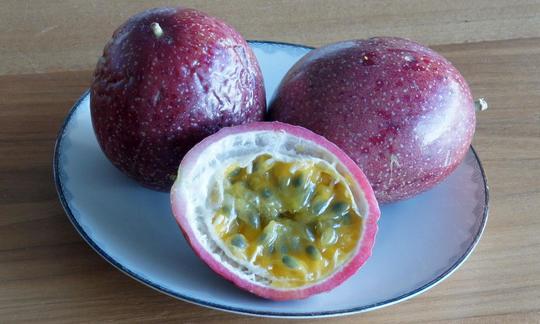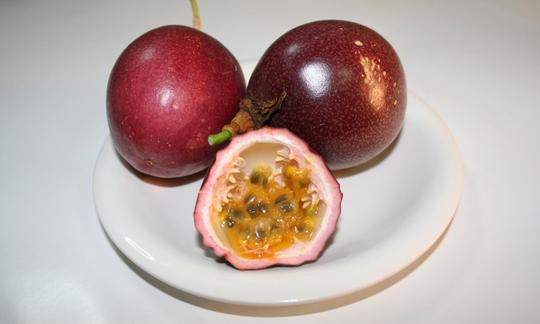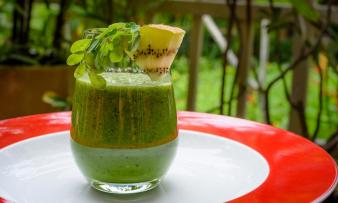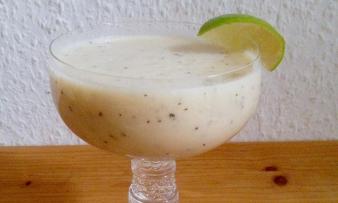Passion fruit (Passiflora edulis) is classified as a berry and is in the Passifloraceae family (Passifloraceae). There are two very common varieties that are used to flavor both sugary drinks and fruit drinks: edulis f. edulis, a dark purple variety, and edulis f. flavicarpa, a greenish yellow variety. Both types of passion fruit are widely available in Europe and North America. Passion fruit is known as maracujá in Portuguese, maracuyá or parcha in Spanish, grenadille or fruit de la passion in French, and Passionsfrucht or Maracuja in German. The origin of the fruit’s names in these various languages is not always clear.
Culinary uses:
- Fruit: The edible fruit of Passiflora edulis is eaten raw and used to make juice and is also exported to Europe. The fruit of f. flavicarpa (greenish yellow) is somewhat less aromatic than that of f. edulis (dark purple); given its higher acid content, f. flavicarpa is the better choice for making juice. The fruit of f. edulis, on the other hand, is the passion fruit most frequently sold in Central European supermarkets. The fruit is also used in various ice cream and dessert creations, for example, in the meringue-based dessert pavlova.
- Seeds: The oil obtained from Passiflora edulis seeds is used primarily in cosmetics (e.g., sun protection products and massage oils). The main ingredients are linoleic acid, oleic acid, and palmitic acid.
- Leaves: Along with other Passifloraceae species, the leaves of Passiflora edulis are used in South America as a diuretic, for inflammations, and as a natural remedy for asthma. The flavonoids contained in passion flower sedatives and sleep aids have been identified as those in the leaves of Passiflora edulis (although commonly available preparations are based on Passiflora incarnata).2
The tradition of using passion fruit and related species for medicinal purposes can be traced back to native American traditional medicine as well as the medicinal remedies of European settlers in North America.
Nutritional information:
Passion fruit juice contains sugar (sucrose, glucose, and fructose) and organic acids (predominantly citric acid and malic acid). On average, the vitamin C content comes in at about 30 to 50 mg/100 ml. Furthermore, niacin (formerly: vitamin B3) and riboflavin (vitamin B2) are present in notable amounts. Among the carotenoids found in passion fruit, beta-carotene dominates. A number of volatile esters (e.g., ethyl acetate, ethyl butanoate, hexyl butanoate, hexyl hexanoate, and ethyl hexanoate) are the substances mainly responsible for the aromatic flavor.
Several varieties of passionfruit are rich in polyphenol content, and yellow varieties of the fruit were found to contain prunasin and other cyanogenic glycosides in the peel and juice.1
General information:
From Wikipedia: Passiflora edulis is a vine species of passion flower that is native to southern Brazil through Paraguay and northern Argentina. It is cultivated commercially in tropical and subtropical areas for its sweet, seedy fruit. The passion fruit is a pepo, a type of berry, round to oval, either yellow or dark purple at maturity, with a soft to firm, juicy interior filled with numerous seeds. The fruit is both eaten and juiced; passion fruit juice is often added to other fruit juices to enhance aroma.
... Several distinct varieties of passion fruit with clearly differing exterior appearances exist. The bright yellow flavicarpa variety, also known as yellow or golden passionfruit, can grow up to the size of a grapefruit, has a smooth, glossy, light and airy rind, and has been used as a rootstock for purple passionfruit in Australia.1
Etymology:
The passion fruit is so called because it is one of the many species of passion flower, leading to the English translation of the Latin genus name, Passiflora. Around 1700, the name was given by missionaries in Brazil as an educational aid while trying to convert the indigenous inhabitants to Christianity; its name was flor das cinco chagas or "flower of the five wounds" to illustrate the crucifixion of Christ, with other plant components also named after an emblem in the Passion of Jesus. The name maracuyá or maracujá comes from a Guaraní word meaning "nursery for flies". In the Dominican Republic, the fruit is called chinola, which is probably derived from the word China where the orange, a similar-looking fruit, originated.1
Literature/Sources:
- Wikipedia. Passiflora edulis [Internet]. Version dated October 7, 2018 [Cited October 8, 2018].
- Wikipedia (in German). Passiflora edulis [Internet]. Version dated February 5, 2018 [Cited October 8, 2018].
Nutrient tables
The complete nutritional information, coverage of the daily requirement and comparison values with other ingredients can be found in the following nutrient tables.
|
Nutritional Information
|
per 100g |
2000 kcal The numbers show the percent of the recommended daily value for a person who consumes 2000 cal per day. This number is for one serving of the recipe. A person normally eats multiple times a day and consumes additional nutrients. You can get all of the nutrients you need over a longer period of time and in this way ensure a healthy balance. |
|---|---|---|
| Energy | 97 kcal 406 kJ | 4.9% Recommended daily allowance according to the GDA: 2000kcal |
| Fat/Lipids | 0.70 g | 1.0% Recommended daily allowance according to the GDA: 70g |
| Saturated Fats | 0.06 g | 0.3% Recommended daily allowance according to the GDA: 20g |
| Carbohydrates (inc.dietary fiber) | 23 g | 8.7% Recommended daily allowance according to the GDA: 270g |
| Sugars | 11 g | 12.4% Recommended daily allowance according to the GDA: 90g |
| Fiber | 10 g | 41.6% Recommended daily allowance according to the GDA: 25g |
| Protein/Albumin | 2.2 g | 4.4% Recommended daily allowance according to the GDA: 50g |
| Cooking Salt (Na:28.0 mg) | 71 mg | 3.0% Recommended daily allowance according to the GDA: 2.4g |
| Essential micronutrients with the highest proportions | per 100g | 2000 kcal | |
|---|---|---|---|
| Vit | Vitamin C (ascorbic acid) | 30 mg | 38.0% Recommended daily allowance according to the EU: LMIV-2011: 80 mg |
| Elem | Potassium, K | 348 mg | 17.0% Recommended daily allowance according to the EU: LMIV-2011: 2'000 mg |
| Min | Iron, Fe | 1.6 mg | 11.0% Recommended daily allowance according to the EU: LMIV-2011: 14 mg |
| Elem | Phosphorus, P | 68 mg | 10.0% Recommended daily allowance according to the EU: LMIV-2011: 700 mg |
| Vit | Biotin (ex vitamin B7, H) | 5.0 µg | 10.0% Recommended daily allowance according to the EU: LMIV-2011: 50 µg |
| Min | Copper, Cu | 0.09 mg | 9.0% Recommended daily allowance according to the EU: LMIV-2011: 1.0 mg |
| Vit | Niacin (née vitamin B3) | 1.5 mg | 9.0% Recommended daily allowance according to the EU: LMIV-2011: 16 mg |
| Vit | Riboflavin (vitamin B2) | 0.13 mg | 9.0% Recommended daily allowance according to the EU: LMIV-2011: 1.4 mg |
| Vit | Vitamin A, as RAE | 64 µg | 8.0% Recommended daily allowance according to the EU: LMIV-2011: 800 µg |
| Elem | Magnesium, Mg | 29 mg | 8.0% Recommended daily allowance according to the EU: LMIV-2011: 375 mg |
Detailed micronutrients and daily requirement coverage per 100g
Explanations of nutrient tables in general
The majority of the nutritional information comes from the USDA (US Department of Agriculture). This means that the information for natural products is often incomplete or only given within broader categories, whereas in most cases products made from these have more complete information displayed.
If we take flaxseed, for example, the important essential amino acid ALA (omega-3) is only included in an overarching category whereas for flaxseed oil ALA is listed specifically. In time, we will be able to change this, but it will require a lot of work. An “i” appears behind ingredients that have been adjusted and an explanation appears when you hover over this symbol.
For Erb Muesli, the original calculations resulted in 48 % of the daily requirement of ALA — but with the correction, we see that the muesli actually covers >100 % of the necessary recommendation for the omega-3 fatty acid ALA. Our goal is to eventually be able to compare the nutritional value of our recipes with those that are used in conventional western lifestyles.
| Essential fatty acids | per 100g |
2000 kcal The numbers show the percent of the recommended daily value for a person who consumes 2000 cal per day. This number is for one serving of the recipe. A person normally eats multiple times a day and consumes additional nutrients. You can get all of the nutrients you need over a longer period of time and in this way ensure a healthy balance. |
|---|---|---|
| Linoleic acid; LA; 18:2 omega-6 | 0.41 g | 4.0% Recommended daily allowance according to the CH-EDI-Verordnung: 10 g |
| Alpha-Linolenic acid; ALA; 18:3 omega-3 | 0.00 g | < 0.1% Recommended daily allowance according to the CH-EDI-Verordnung: 2.0 g |
| Vitamins | per 100g |
2000 kcal The numbers show the percent of the recommended daily value for a person who consumes 2000 cal per day. This number is for one serving of the recipe. A person normally eats multiple times a day and consumes additional nutrients. You can get all of the nutrients you need over a longer period of time and in this way ensure a healthy balance. |
|---|---|---|
| Vitamin C (ascorbic acid) | 30 mg | 38.0% Recommended daily allowance according to the EU: LMIV-2011: 80 mg |
| Biotin (ex vitamin B7, H) | 5.0 µg | 10.0% Recommended daily allowance according to the EU: LMIV-2011: 50 µg |
| Riboflavin (vitamin B2) | 0.13 mg | 9.0% Recommended daily allowance according to the EU: LMIV-2011: 1.4 mg |
| Niacin (née vitamin B3) | 1.5 mg | 9.0% Recommended daily allowance according to the EU: LMIV-2011: 16 mg |
| Vitamin A, as RAE | 64 µg | 8.0% Recommended daily allowance according to the EU: LMIV-2011: 800 µg |
| Vitamin B6 (pyridoxine) | 0.10 mg | 7.0% Recommended daily allowance according to the EU: LMIV-2011: 1.4 mg |
| Folate, as the active form of folic acid (née vitamin B9 and | 14 µg | 7.0% Recommended daily allowance according to the EU: LMIV-2011: 200 µg |
| Vitamin K | 0.70 µg | 1.0% Recommended daily allowance according to the EU: LMIV-2011: 75 µg |
| Thiamine (vitamin B1) | 0 mg | < 0.1% Recommended daily allowance according to the EU: LMIV-2011: 1.1 mg |
| Vitamin D | 0 µg | < 0.1% Recommended daily allowance according to the EU: LMIV-2011: 5.0 µg |
| Vitamin E, as a-TEs | 0.02 mg | < 0.1% Recommended daily allowance according to the EU: LMIV-2011: 12 mg |
| Essential macroelements (macronutrients) | per 100g |
2000 kcal The numbers show the percent of the recommended daily value for a person who consumes 2000 cal per day. This number is for one serving of the recipe. A person normally eats multiple times a day and consumes additional nutrients. You can get all of the nutrients you need over a longer period of time and in this way ensure a healthy balance. |
|---|---|---|
| Potassium, K | 348 mg | 17.0% Recommended daily allowance according to the EU: LMIV-2011: 2'000 mg |
| Phosphorus, P | 68 mg | 10.0% Recommended daily allowance according to the EU: LMIV-2011: 700 mg |
| Magnesium, Mg | 29 mg | 8.0% Recommended daily allowance according to the EU: LMIV-2011: 375 mg |
| Sodium, Na | 28 mg | 4.0% Recommended daily allowance according to the EU: LMIV-2011: 800 mg |
| Calcium, Ca | 12 mg | 2.0% Recommended daily allowance according to the EU: LMIV-2011: 800 mg |
| Essential trace elements (micronutrients) | per 100g |
2000 kcal The numbers show the percent of the recommended daily value for a person who consumes 2000 cal per day. This number is for one serving of the recipe. A person normally eats multiple times a day and consumes additional nutrients. You can get all of the nutrients you need over a longer period of time and in this way ensure a healthy balance. |
|---|---|---|
| Iron, Fe | 1.6 mg | 11.0% Recommended daily allowance according to the EU: LMIV-2011: 14 mg |
| Copper, Cu | 0.09 mg | 9.0% Recommended daily allowance according to the EU: LMIV-2011: 1.0 mg |
| Zinc, Zn | 0.10 mg | 1.0% Recommended daily allowance according to the EU: LMIV-2011: 10 mg |
| Selenium, Se | 0.60 µg | 1.0% Recommended daily allowance according to the EU: LMIV-2011: 55 µg |
| Iod, I (Jod, J) | 1.3 µg | 1.0% Recommended daily allowance according to the EU: LMIV-2011: 150 µg |












Comments